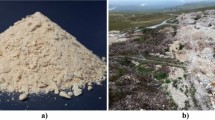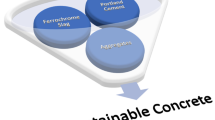Abstract
The purpose of this paper is an investigation of the possible role of supplementary cementing materials (SCMs) on the water retaining ability of hydrated lime (CL90) and Portland cement (PC) mortars. Desorptivity (R) defines the water retaining ability of mortars in the freshly-mixed wet state. Transfer sorptivity (A) defines the ability of the substrate to withdraw water from the wet mix. The time to dewater (t dw), is an expression derived from the sharp front theory, and enables calculation of the time taken for a wet mortar joint to be dewatered by an absorbent substrate. The results show that the very water retaining CL90 mortars become progressively more water releasing with increased volume fraction replacement levels of both ground granulated blast-furnace slag (GGBS) and fly ash (FA). On the other hand, the very water releasing PC mortars become more water retaining with the addition of silica fume (SF). Results also show that transfer sorptivity increases as the volume fraction replacement levels of GGBS and FA increases in CL90 mortars and decreases with increased volume fraction replacement levels of SF in PC mortars. Since the time taken to dewater a mortar joint (t dw) is inversely proportional to the squared transfer sorptivity, t dw can be dramatically altered by the addition of SCMs in both CL90 and PC mortars. These parameters have important practical consequences, not only in the initial adhesion of the mortar to the substrate but also in the strength of the set material. The ability to manipulate the water retaining properties can also allow construction time to be reduced.







Similar content being viewed by others
References
API specification 10 (1998) American Petroleum Institute, Northwest, Washington, DC
BSI (1997) Tests for geometrical properties of aggregates. Determination of particle size distribution. Sieving method. BS EN 933 Part 1
BSI (1999) Methods of test for mortar for masonry. Bulk sampling of mortars and preparation of test mortars. BS EN 1015 Part 2
BSI (2000) Cement. Composition, specifications and conformity criteria for common cements. BS EN 197 Part 1
BSI (2002) Aggregates for mortar. BS EN 13139
BSI (2005) Fly ash for concrete. Definition, specifications and conformity criteria. BS EN 450 Part 1
BSI (2006) Ground granulated blast furnace slag for use in concrete, mortar and grout. Definitions, specifications and conformity criteria. BS EN 15167 Part 1
BSI (2009) Silica fume for concrete. Definitions, requirements and conformity criteria. BS EN 13263 Part 1
BSI (2010) Building Lime. Definitions, specifications and conformity criteria. BS EN 459-1:2010
Carter MA, Green KM, Wilson MA, Hoff WD (2003) Measurement of the water retentivity of cement mortars. Adv Cem Res 15(4):155–159
Collier NC, Wilson MA, Carter MA, Hoff WD, Hall C, Ball RJ, El-Turki A, Allen GC (2007) Theoretical development and validation of a sharp front model of the dewatering of a slurry by an absorbent substrate. J Phys D 40(13):4049–4054
Domone P, Illston J (2010) Construction materials: their nature and behaviour, 4th edn. Taylor & Francis, London, Chap 3
El-Turki A, Ball RJ, Carter MA, Wilson MA, Ince C, Allen GC (2010) Effect of dewatering on the strength of lime and cement mortars. J Am Ceram Soc 93(7):2074–2081
Green KM, Carter MA, Hoff WD, Wilson MA (1999) The effects of lime and admixtures on the water-retaining properties of cement mortars. Cem Concr Res 29(11):1743–1747
Ince C, Carter M, Wilson M, El-Turki A, Ball R, Allen G, Collier N (2010) Analysis of the abstraction of water from freshly mixed jointing mortars in masonry construction. Mater Struct 43(7):985–992
Ince C, Carter M, Wilson M, Collier N, El-Turki A, Ball R, Allen G (2011) Factors affecting the water retaining characteristics of lime and cement mortars in the freshly-mixed state. Mater Struct 44(2):509–516
Hall C, Hoff WD (2002) Water transport in brick, stone and concrete. Spoon Press, London
Philip JR (1957) The theory of infiltration: 4. Sorptivity and algebraic infiltration equations. Soil Sci 84(3):257–264
Author information
Authors and Affiliations
Corresponding author
Rights and permissions
About this article
Cite this article
Ince, C., Ozturk, Y., Carter, M.A. et al. The influence of supplementary cementing materials on water retaining characteristics of hydrated lime and cement mortars in masonry construction. Mater Struct 47, 493–501 (2014). https://doi.org/10.1617/s11527-013-0074-9
Received:
Accepted:
Published:
Issue Date:
DOI: https://doi.org/10.1617/s11527-013-0074-9




